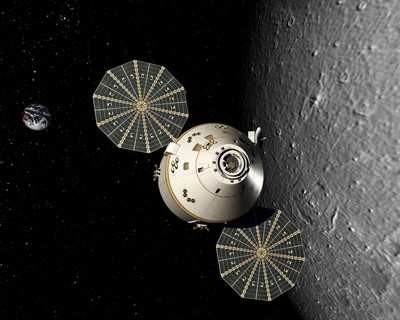First Full-Size Orion Mockup Heading To White Sands
Returning humans to the moon by 2020 may seem like a distant
goal for NASA... but the agency's Constellation Program already has
scheduled the first test flight toward that goal to take place in
less than 12 months. The 90-second flight will not leave Earth's
atmosphere, but it will be an important first step toward
demonstrating how NASA intends to build safety into its next
generation of spacecraft, including the Ares I and V rockets and
the Orion crew capsule.

The first in a series of unmanned abort tests, known as Pad
Abort-1 or PA-1, is scheduled for late 2008 at the US Army's White
Sands Missile Range near Alamogordo, NM. The tests will help verify
that NASA's newly-developed spacecraft launch abort system can
provide a safe escape route for astronauts in the Orion crew
capsule in the event of a problem on the launch pad or during
ascent into low Earth orbit atop the Ares I rocket.
Orion is the Constellation Program's new crew exploration
vehicle, set to carry as many as four crew members to lunar orbit
and return its crew safely to Earth after missions to the moon's
surface. The 5-meter (16.5 foot) wide, cone-shaped capsule also
will provide transport services to the International Space Station
for as many as six crew members.
But before launching to the moon or to the International Space
Station, system tests on Earth have to prove the technologies
work.

The pad abort test will simulate an emergency on the launch pad.
Upon command from a nearby control center, a dummy Orion crew
module -- which would sit on top of a rocket for an actual launch
-- will be ejected directly from the launch pad by its
rocket-propelled launch abort system to about one mile in altitude
and nearly one mile downrange.
That is why engineers and technicians at NASA's Langley Research
Center in Hampton, Va., NASA's Dryden Flight Research Center in
Edwards, Calif., and industry partners on the Orion Project are
taking particular care to fabricate and equip the first flight test
articles with extreme precision.
Engineers and technicians at Langley designed and fabricated the
structural shell of the simulated crew module for the first pad
abort test and now are conducting a series of ground checks on the
structure. The "crew module simulator," as it is called, accurately
replicates the size, outer shape and mass characteristics of the
Orion crew module.

"The next step is to ship the completed crew module simulator to
Dryden, where they will outfit it with the smarts -- the computers,
the electronics, the instrumentation -- all the systems that need
to work in conjunction with the structure," said Phil Brown,
manager of the Langley Orion Flight Test Article Project.
After the instrumented dummy crew module is delivered to White
Sands this summer, it will be integrated with the PA-1 launch abort
system flight test article, a vertical tower containing the escape
rocket motor and a guiding rocket motor currently under
construction at Orbital Sciences, Inc. in Dulles, VA. The combined
crew module and launch abort system will be placed on the launch
pad being constructed especially for the abort flight test
series.
During the pad abort test sequence, the escape system's main
abort motor will fire for several seconds, rapidly lifting the
simulated crew module from the test launch pad, after which the
escape system will detach, and three 116-foot-diameter parachutes
will deploy to slow the module for landing.
The test will provide early data for design reviews to follow
and will be followed by an ascent abort test in 2009 and a second
pad abort test scheduled for 2010, both at White Sands. A parallel
series of higher-altitude launch tests will commence at NASA's
Kennedy Space Center in Florida in 2009.
"These flight tests will either confirm that our system works or
help us identify and correct any defects that surface," said Greg
Stover, manager of the Orion Launch Abort System Project Office,
located at Langley. "Our goal is that on every manned mission the
launch abort system will be the most reliable system that we
hopefully never have to use."

In addition to Langley, Dryden and Kennedy, the Orion Project
launch abort system team and the abort flight test team includes
members from NASA's Marshall Space Flight Center in Huntsville, AL;
NASA's Johnson Space Center in Houston and NASA's Glenn Research
Center near Cleveland -- as well as Orion Project prime contractor,
Lockheed Martin of Denver, CO; and its subcontractor, Orbital
Sciences Inc. of Dulles, VA.
The Orion Project Office, located at Johnson, is leading the
development of the Orion spacecraft for the Constellation Program,
which also includes the Ares I and Ares V launch vehicles, the
Altair human lunar lander and lunar surface systems to support
sustained crew habitation.
 ANN's Daily Aero-Term (04.24.24): Runway Lead-in Light System
ANN's Daily Aero-Term (04.24.24): Runway Lead-in Light System ANN's Daily Aero-Linx (04.24.24)
ANN's Daily Aero-Linx (04.24.24) Aero-FAQ: Dave Juwel's Aviation Marketing Stories -- ITBOA BNITBOB
Aero-FAQ: Dave Juwel's Aviation Marketing Stories -- ITBOA BNITBOB Classic Aero-TV: Best Seat in The House -- 'Inside' The AeroShell Aerobatic Team
Classic Aero-TV: Best Seat in The House -- 'Inside' The AeroShell Aerobatic Team Airborne Affordable Flyers 04.18.24: CarbonCub UL, Fisher, Affordable Flyer Expo
Airborne Affordable Flyers 04.18.24: CarbonCub UL, Fisher, Affordable Flyer Expo






